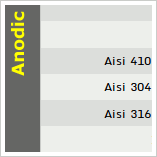|
| Ship's Log - Materials | |||||||||||||||||||||||||||||||||||||||||||||||||||||||||||||||||||
| 01/03/2002 | |||||||||||||||||||||||||||||||||||||||||||||||||||||||||||||||||||
|
Electrochemical corrosion is the dissolution of a metal through the oxidation process and can be defined as "degradation of a metal by an electrochemical reaction with its environment". This phomena also known as galvanic corrision. The basic unit in which electrochemical reactions occur is the electrolytic cell. An electrolytic cell consists of three components;
The anode is the site of oxidation and therefore the site of corrosion. The anode and cathode are electrically connected. The medium surrounding the anode and cathode is the electrolyte. In the absence of any one of these components, the electrochemical corrosion reaction will stop. Any metal when immersed in an electrically conductive fluid, has a specific electrical potential that is measurable as a voltage and each metal has a different electrical potential when immersed in the same electrolyte such as sea water. According to the potential difference of these two metals, the current flows from higher voltage metal to the lower one. This action raises the voltage of the lower-voltage metal above its natural potential. To establish the equilibrium, the lower-voltage metal discharges a current in to the electrolyte.
Table.1) Galvanic series for some metals and alloys in sea water. There is a greater likelihood for galvanic corrosion between the two connected metals when the difference of the electrical potential is greater between them. [3]
The current passes through the electrolyte back to the higher-voltage metal and completes the electrical circuit between the two pieces. The current flowing through the electrolyte is generated by an electrochemical reaction that steadily consumes the lower-voltage metal a process. This is the galvanic corrosion. References1. Corrosion Basics and Computer Modeling, 1986, V.G. DeGiorgi2. Corrosion for Students of Science and Engineering, 1988, K. R. Trethewey - J. Chamberlain 3. Corrosion in Sea Water - Professional Boat Builder - December/January, 1995, Nigel Calder |
|||||||||||||||||||||||||||||||||||||||||||||||||||||||||||||||||||
